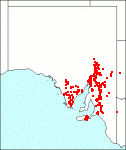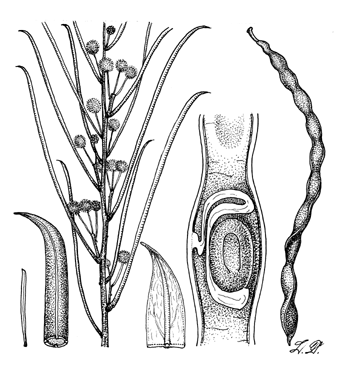Family: Fabaceae
Acacia calamifolia
Citation:
J. Lindley, Edward's Bot. Reg. 10:t.839 (1824).
Derivation: calamus (Latin)--a reed; folium (Latin)--leaf. Synonymy: A. euthycarpa (J. M. Black) J. M. Black, Trans. Roy. Soc. S. Austral. 69:310 (1945); Trans. Roy. Soc. S. Austral. 71:20 (1947). Syn. A. calamifolia var. euthycarpa J. Black, Trans. Roy. Soc. S. Austral. 47:369 (1923)., Acacia microcarpa, Acacia pulverulenta Common name: Wallowa
Description:
Tall, erect, glabrous, rounded, bushy shrubs 2--4 m high; branchlets slender, terete, ascending, reddish or somewhat mealy; bark smooth, grey on older stems. Phyllodes linear, 4-12 cm long, 1-5 mm broad, mainly terete-compressed but sometimes flat, straight or slightly curved, sometimes appearing scurfy or farinaceous, obscurely 1-veined on each face but 4-veined in all when terete; apex always uncinate; when phyllodes are more than 2 mm broad then broadest near the apex and tapering gradually towards the base; glands small, situated on upper margin 5-10 mm from the base of the phyllodes. Inflorescences axillary and solitary or 2-4 in very short racemes; flower-heads globular, yellow, 30-40-flowered; peduncles slender, glabrous, 5-10 mm long; flowers 5-merous. Legumes linear, 7-15 cm long, 5-6 mm broad, straight or curved, sometimes appearing flexuose when viewed from the side, raised and wrinkled over the seeds; margins straight-edged or slightly constricted to moniliform. Seeds longitudinal in legume, obloid; funicle in a double fold, half or more encircling the seed and thickened into a fleshy aril.
|
|
Distribution:
|
Common in the Eyre Peninsula, Yorke Peninsula, Flinders Ranges, Northern and Southern Lofty, Kangaroo Island, South-Eastern, Murray and Eastern regions, mainly associated with woodland and open scrub. Soils; on a variety of soils mainly shallow calcareous sandy alkaline yellow duplex or hard neutral yellow duplex. Rainfall 200-700 mm. Also N.S.W. and Vic.
S.Aust.: FR, EA, EP, NL, MU.
|
Flowering time: Mainly in spring from August — November but can often be found sparsely flowering in summer and autumn months. |

SA Distribution Map based
on current data relating to
specimens held in the
State Herbarium of South Australia
|
Biology:
No text
Related taxa:
Acacia rivalis differs mainly in always having flat phyllodes with a small gland further from the base and flower-heads 4-10 in racemes. J. M. Black, Fl. S. Austral. Pt. 2. 415 (1948), distinguished Acacia euthycarpa from A. calamifolia by its straight edged legumes which are flexuose in appearance. These do not appear to be reliable characters and at this stage Acacia euthycarpa cannot be satisfactorily distinguished from A. calamifolia. It is therefore included within it. A. microcarpa var. linearis Black was described from material from near Monarto South and was considered to be conspecific with A. x grayana. Leach & Whiffin (1978) suggest that both of these are hybrids or intermediates between A. calamifolia and A. brachybotrya.
Taxonomic notes:
For discussion of hybrids with A. brachybotrya(A. x grayana) see notes under that species or Leach & Whiffin (1978).The only mistletoe found on Acacia calamifolia has been a single collection of Amyema preissii.
Cultivation:
An attractive shrubby wattle, well worth growing as an ornamental and suitable for low shelter belt or roadside planting. A fast growing species adaptable to damp situations as well as drier areas.
Author:
Not yet available
References:
Source:

|

